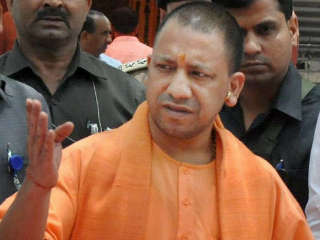By Dr Jagan Kaul & Krishan Bhatnagar
The Taj corridor scheme on the banks of river Yamuna was stopped by the Supreme Court on the ground that it would threaten the historic Taj Mahal. Similarly the Delhi Metro Rail route was changed when the older scheme was considered dangerous to the historic Qutub Minar. The same sense of history, culture and preservation must be applied in the case of Ram Sethu.
The Hindus all over the world are dismayed at creating the so-called Sethusamudram Shipping Canal Project (SSCP), which has been given charge to demolish the historic Ram Sethu. This is in continuation of the Indian authorities’ efforts to humiliate and disintegrate Hindus by taking total control of temples and endowments and expelling the Hindu community from them. The Kanchi Shankaracharya’s arrest on concocted charges was yet another blow towards the same goal. In its anti-Hindu crusade the Indian officialdom did not stop here. Rather than remaining even handed it encouraged nay boosted, minority religious fundamentalism to enforce a divide and rule strategy that could further divide and disintegrate Bharat, the land of Hindus.
Hinduism is under an assault as never before. Given the lethal nature of this attack it is time for a Gandhian type mass movement for protecting religious freedom and dharma samsthapana. The agenda of this movement could include:-
1.protection and maintenance of the Ram Sethu;
2.protection and freedom of the Hindu temples, religious infrastructure and cultural centres from the onslaught launched by government and for their governance by autonomous Hindu Boards;
3.integration of weaker sections in the mainstream;
4.amendment to the divisive Article 30 of the Constitution; and
5.creating an all important Hindu vote bank for ensuring righteous governance of the country.
Dredging work at Ram Sethu, which is a part of Ramayana and is deeply embedded in the Hindu psyche, hurts intensely the religious beliefs and sentiments while causing heightened degrees of distress and deep resentment among billions of Hindus worldwide. The Ram Sethu must be classified as religious, cultural, historical and an ancient monument of invaluable archaeological importance. Unlike many others, this site has immense traditional and cultural value for the vast majority of Indian citizens. The bridge has been revered by the entire Hindu civilisation since times immemorial.
It should be noted that the Taj corridor scheme on the banks of river Yamuna was barred by the Supreme Court on the ground that it would threaten the historic Taj Mahal. Similarly the Delhi Metro Rail route was changed when the older scheme was considered dangerous to the historic Qutub Minar. The same sense of history, culture and preservation must be applied in the case of Ram Sethu.
If the ongoing destructive process is not stopped right away, there should be highly critical and unfavourable comments in every Ramayana Katha now and for ever, that there was a Congress regime that in utter violation of the sense and sensibility of the Indian masses heartlessly destroyed the age old traditional and sacred Ram Sethu.
The destruction of Ram Sethu is a symptom of deep malaise, which is amply proven by injurious government control of Hindu temples. There is a concerted effort by the so-called secular political establishment to de-Hinduise India by applying the colonial policy of divide and rule. Therefore, we may also need a strong nationwide campaign for promoting the change of mindset in the uncaring authorities.
As the ongoing developments suggest some of the State Governments in the South are in the forefront for demolition of Hinduism and its religious infrastructure under their jurisdiction. Furthermore, the self professed secular Government of India has become an active participant in promoting competing religions while funding their enlargement from the Hindu coffers.
In Andhra Pradesh, a state where non-transparency and non-accountability for Hindu endowments under Government management is a rule rather than exception, utilises the huges resources of TTD for many non-Hindu purposes. This loot takes place without any legitimate constitutional authority. The world famous Tirupathi Tirumala temple receives an annual income of Rs. 3,100 crore in the form of direct cash collected from various sources. In the financial year 2005-06, the TTD collected 2,400 Kgs of gold, 2,33,000 Kgs of silver and 543 Kgs of other precious stones including diamonds, rubies, etc. from the devotees. How such enormously large amounts were used for the benefit of the community has never been revealed. In the absence of any factual and public explanation how can one trust the authorities whose anti-Hindu antecedents are already well established?
According to the latest official pronouncements, the Andhra Pradesh Government is going all out for taking over the entire spectrum of Hindu religious institutions. The Endowment Minister, Diwakar Reddy, announced on March 12 that the Government has decided to take over all temples, mutts and religious trusts in the state. Additionally, the state Government was planning to amend the AP Endowments Act to enable the Endowments Commissioner to oversee the day-to-day administration of mutts. It clearly amounts to Hinduism being made a "keep of the state" in A.P. The number of temples under government control has gone up to over 184,000 from about 33,000 a few years ago, and under the new plan the state wants to take over even smallest of private temples.
The world famous TTD with massive income of over Rs. 3,000 crore and vast endowments properties and Hindu educational institutions have been infiltrated, particularly by Christians under the patronage of Chief Minister Rajashekhar Samuel Reddy. There was a recent news of protests and tension at TTD’s Sri Padmavathi Mahila Viswa Vidyalayam (SPMVV) on March 14 , 2007, against university Vice Chancellor Veena Nobel Das for the alleged propagation of Christianity in the varsity and the recent suicide by a first year post-graduate student K. Uma Maheswari in the varsity hostel room against conversion.
In Tamil Nadu, through the out right abuse of Government power two top Hindu institutions, Shankaracharya and the Kanchi Mutt, have been marginalised and rendered dysfunctional. The Shankaracharya, whose status is not less than the Pope for Hindus, was arrested on Diwali night in 2004. He was humiliated, put in jail without bail and treated like a common criminal. Such a barbaric action against the most revered leader of the highly civilised and non-violent faith was tantamount to a serious assault on Hinduism and its leadership. It is over two years now that neither the case against him has been proven nor has he been exonerated. There are serious allegations that heavy corruption and bribery was involved in getting him arrested and getting the anti-conversion Act repealed in Tamil Nadu.
In Kerala, the Government hastily promulgated an ordinance on February 4, 2007 to disband the Travancore and Cochin Autonomous Devaswom Boards (TCDB) and usurped their authority. The timing, intent and integrity of the said ordinance was extremely suspicious and questionable particularly in view of the impending session of the State Assembly and the existence of a three man Commission appointed by the High Court for investigating the allegations of corruption.
In the current fiscal year secular Kerala’s treasury was filled with Rs. 268 crore solely by the revenue from temples under Travancore Devaswom Board, Cochin Devaswom Board and Guruvayur Devaswom, but how much of it was used for temple maintenance and the Hindu causes remains a mystery. According to some reports, out of tens of thousands of temples that have been rendered dysfunctional, only a few hundred are currently fully operational. As if that was not enough, under the Kerala Land Reforms Act, 13,000 acres of Guruvayoor’s land has been reduced to 230 acres amounting to 98 per cent land grab.
In Karnataka, the Government has set new standards of lawlessness by taxing the temples and without any justifiable legal authority simply diverting their funds to enhance the madrasas and run churches—both being the adversarial religions against Hinduism. In the year 2002-2003, out of Rs 79 crore of temple revenues, Rs. 59.15 crore were given away to mosques, madrasas, Haj, etc., Rs. 12.75 crores were given to Christian institutions and mere Rs. 7.1 crore were allocated to maintain over 248,000 temples. Nowhere in the world does a Government engage in such robbery of one religion to benefit its competitors.
Our priority must be saving Hinduism and its religious infrastructure. Undoubtedly the Ram temple issue is an important one. However, its nature under the present divisive political climate has rather become somewhat contentious, we strongly believe that a step by step process for revitalising the Hindu society is a pre-requisite for achieving this goal.
We must demand that Government allow Hindu Advisory Councils for overseeing the Endowments Departments. Such Councils could be elected by the community or nominated by religious organisations like Dharma Sansad and Hindu Dharma Acharya Sabha for providing oversight and guidance to Government. They could simultaneously eliminate anti-Hindu policies and non-Hindu personnel from the temple management till the denationalisation is realised. Should the Government refuse to set up such an apparatus that could justify launching a protest movement.
http://www.organise r.org/dynamic/ modules.php? name=Content& pa=showpage& pid=181&page= 17
(The writers can be contacted at Hindu Jagran Forum (USA) email: [email protected])
Related HJS Campaign
>Save Sree Ram Setu

 MHA issues first set of citizenship certificates under CAA to 14 applicants
MHA issues first set of citizenship certificates under CAA to 14 applicants Bangladesh: Hindu girl sentenced to 5 years in jail over accusation of ‘blasphemy’
Bangladesh: Hindu girl sentenced to 5 years in jail over accusation of ‘blasphemy’ Dehradun: Ahtasam and Sahil rape 2 Hindu minor sisters after entrapping them in love affair
Dehradun: Ahtasam and Sahil rape 2 Hindu minor sisters after entrapping them in love affair PFI formed death squads to kill Hindus after they murdered RSS leader Rudresh: NIA investigation
PFI formed death squads to kill Hindus after they murdered RSS leader Rudresh: NIA investigation Conspiracy to kill Hindu leaders: Shakil Sheikh arrested from Maharashtra by Surat Police
Conspiracy to kill Hindu leaders: Shakil Sheikh arrested from Maharashtra by Surat Police Dream of Ghazwa-E-Hind will not be realised till Qayamat: UP CM Yogi Adityanath
Dream of Ghazwa-E-Hind will not be realised till Qayamat: UP CM Yogi Adityanath